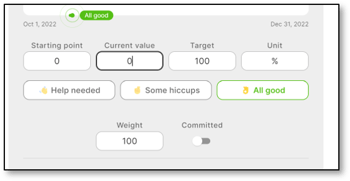Aspirational (stretch) OKRs versus Committed OKRs
What is the difference between these two types of OKRs and when to use them.
Committed OKRs are objectives that a team or individual believes they can achieve (or need to achieve) within a given time frame, based on their current capabilities and resources.
These objectives are meant to be challenging but achievable and they are often used as a way to measure progress and drive performance improvement.
Aspirational or stretch OKRs are objectives that are more ambitious, difficult to achieve and often require additional effort, resources, and creativity to reach.
These objectives are meant to push teams and individuals beyond their comfort zones and encourage them to take risks and strive for breakthrough results.
Committed OKRs are typically used to track progress towards well-defined goals, while aspirational OKRs are used to encourage innovation and drive transformational change.
A balanced approach that includes both Committed and Stretch OKRs can be effective in driving performance, fostering innovation, and encouraging teams and individuals to continuously improve.
How is success measured?
A committed OKR is measured with 100% success.
The percentage of success for an aspirational OKR is set at around 60-70%, recognizing that these objectives are challenging but achievable with effort and dedication. This percentage is meant to provide a level of flexibility and allow for some degree of uncertainty, while still providing a clear and measurable target.
It's important to note that the percentage of success is not a hard and fast rule, and can be adjusted based on the specific needs and circumstances of the situation. The main goal is to set a stretch target that pushes teams and individuals to reach for breakthrough results, while still being achievable with focused effort and dedication.
How many aspirational Key Results per Objective?
The number of aspirational Key Results per objective will depend on the nature and complexity of the objective, and the resources and capabilities of the team or individual responsible for achieving it.
In general, it's recommended to have 1-2 aspirational Key Results per objective, as having too many can make it difficult to focus and prioritize effectively.
How to identify Aspirational and Committed OKRs in TG
- The aspirational or committed component is identified in the Key Result.
- By default in TG all Key Results are aspirational.
- You change the setting from aspirational to committed in the Key Result panel.
 A committed Key Result is identified by a a check mark next to its numerical value.
A committed Key Result is identified by a a check mark next to its numerical value.